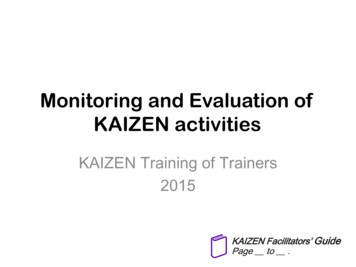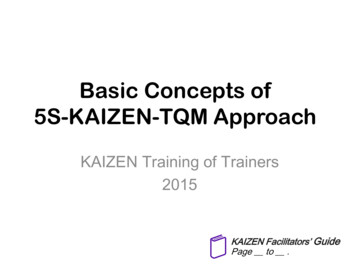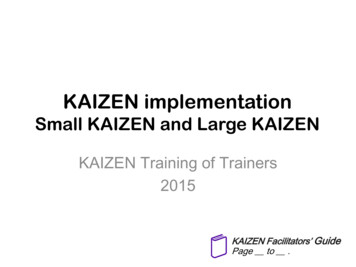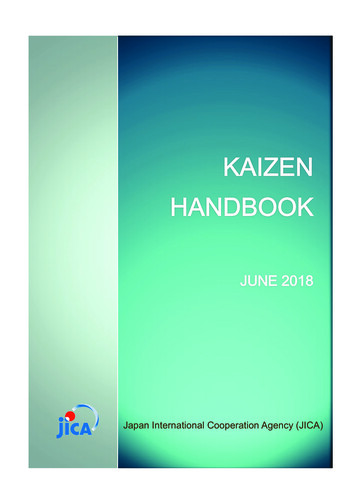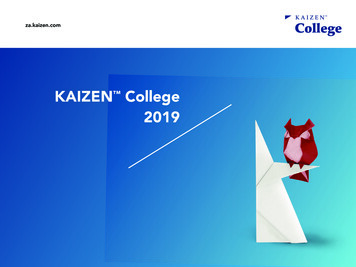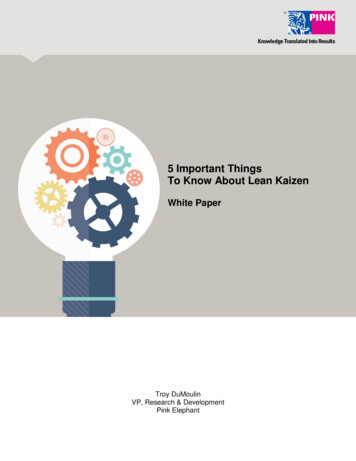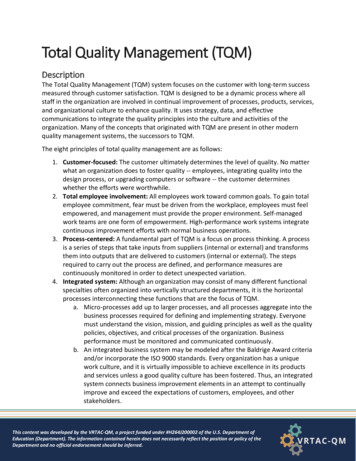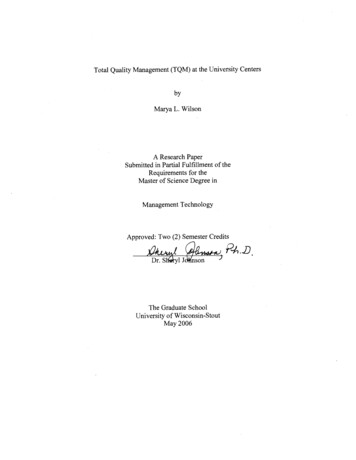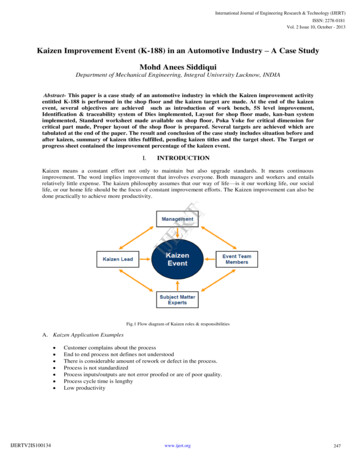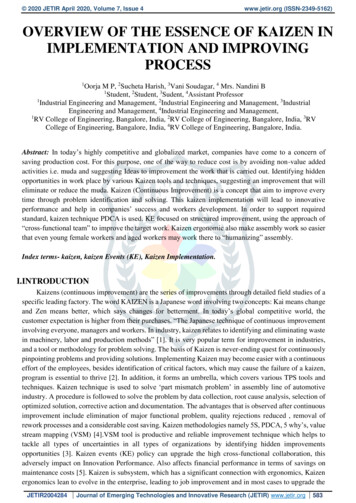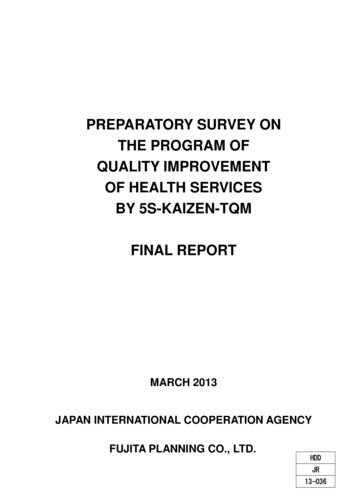
Transcription
PREPARATORY SURVEY ONTHE PROGRAM OFQUALITY IMPROVEMENTOF HEALTH SERVICESBY 5S-KAIZEN-TQMFINAL REPORTMARCH 2013JAPAN INTERNATIONAL COOPERATION AGENCYFUJITA PLANNING CO., LTD.HDDJR13 13 036
PREPARATORY SURVEY ONTHE PROGRAM OFQUALITY IMPROVEMENTOF HEALTH SERVICESBY 5S-KAIZEN-TQMFINAL REPORTMARCH 2013JAPAN INTERNATIONAL COOPERATION AGENCYFUJITA PLANNING CO., LTD.
Summary
Summary1. Introduction and BackgroundDevelopment assistance cooperation aims to achieve the Millennium Development Goals (MDGs)compiled in response to the Milleminum Declaration adopted in UN Millennium Summit in 2000, sothat large fund invested and support programs were conducted.As most of these activities are implemented through expanding the outreach and health centerfunctions to directly support the targets, assistance fund flow is not sufficient for the healthcarefacilities (hospitals) which are core functions in the health system in the relevant countries.For these circumstance, the development of the platform (horizontal development) has come to be hitby a focus in as addition to the direct intervention for each issue (vertical expansion).The management, how the limited resources should be utilized to maximize the effect is required toimprove health services in Africa. Since 2007, JICA has implemented, a program called “Program ofTQM for Better Hospital Services”, introducing ‘5S-KAIZEN-TQM’ approach, which introducesJapanese-style business method in stepwise approach, in healthcare facilities in 15 African countries toaddress this issue.2. Preparatory Survey(1) PurposeThe former preparatory survey was implemented from December 2009 to March 2011, to review theactivities and outputs under the program and to systematize the results of the review. The preparatorysurvey has been continued to March 2013 to put in practice of the recommendations in the survey; tosystematize the program including KAIZEN process. Expected outcome of this preparatory survey arefollowings.a.Cooperative results in “Program of TQM for Better Hospital Services” so far isreviewed( including Review of KAIZEN introduction phase in Group 1 target countries)b.Information is sorted out and transmitted towards systematization of knowledge such as resultsand actual records in “Program of TQM for Better Hospital Services” (transmitting theinformation through creating collection of examples of KAIZEN practices and web page)c.Directions and activities of cooperation utilizing the results of “Program of TQM for BetterHospital Services” are compiled and concrete strategies are formulated.d.With strategies formulated in above c, implementation support and monitoring are carried out forthe pilot activities in each country, and future activity deployment is reviewed such as in projectformation based on these strategies.
(2) ActivitiesMain activities for the survey are supports of the trainings and field survey.1) Supporting training coursesAttend the training course in Japan, Sri Lanka and African regions conducted by JICA TokyoInternational Center, and support the workshops to prepare Action Plans2) Field Surveya.Conducting supervisory trips with resource persons in the target countriesb.Conducting baseline review of the “program of TQM for Better Hospital Service” andsurvey on the existing policy framework and implementation system of the quality ofhealth care services in target countriesc.Collecting information on the related activities of international institutes and otherassistance institutes3. Contents of research and implementation of activities(1) Supporting trainings coursesThe purpose of this training is as follows.1)Prepare for the transition to phase KAIZEN in hospitals is promoted.2)Under the framework of 5S-KAIZEN-TQM, pilot hospital of target countries learn the process tostrengthen the ability of workers and the "organization" for the transition from S4/S5 stage toKAIZEN.Training each time has been improved based on the recommendations of the training of the previous,both to clarify and skills pathway to KAIZEN, derived from the 5S, to enhance the independence ofthe participants, and exercises Q & A adopted the method of progression of participants divided formand presentation.It seems as far as the training evaluation, participants have reached the above target enough, countrieshave started activities KAIZEN is, at the time of the survey guidance tour for the year 2012, Benin,Democratic Republic of Congo, Kenya, Madagascar was only eight countries Mali, Nigeria, Tanzania,and Uganda.(2) Field surveyIn field survey, check the status of implementing the action plan in the strategy paper that "guidancetour" by the committee support a different issue areas to help promote national and 5S implementationof the 5S-KAIZEN was developed by training and regional Survey, was carried out in conjunctionwith international organizations as well as the "Survey Performance Review."
1) Check the state of implementation of the Action Plan15 countries will participate in this program, the status of implementation of the Action PlanStrategy Paper was developed in regional training, the function of the attitude of the leader and QIThad a significant impact.2) Check the state of implementation of 5S-KAIZENDue to demand of the other party, the evaluation using the check sheet has been carried out indifferent ways by the research team and the tour leaders target countries.It is desirable to become the number is "Leadership 3S (organized, tidy, clean) S4, S5" and of theevaluation results, facilities There are many get the same results, 5S activities in an environmentthat is fostering leadership Implementation of that I was able to be confirmed.3) the collection of medical information and hospital managementSummary of the data collected from each hospital is as follows.-In terms of the number of patients, the facility staff strike has occurred to the downward trend ofthe number of patients. The increasing facilities are believed to be due to natural increase.-In terms of Laboratory test, increasing trend has occurred in lower score country of the evaluationresults, decreasing trend is often the group with the highest evaluation results. Causal relationshipis not clear as possible is considered the influence due to the effect of reduction in the number ofpatients or improvement of inspection appropriately by 5S-KAIZEN-TQM.-The number of referrals had shown a downward trend in the hospital's high evaluation results. Thenumber of upper referral has been declined in particular. it means that the hospital can cure thepatients more than before.-With regards to cause of death, while diseases specific to developing countries in Africa such asmalaria, HIV, malnutrition, diarrhea, and anemia were listed for both adult and children alike,lifestyle disease such as high blood pressure and diabetes were reported as that of adult.4) Collection of information on trends in the Ministry of HealthWith regards to the activity plans formulated by Ministries of Health in each country and itsimplementation status, activities relatively progressed according to the plans in the countries whereimplementation systems of the quality improvement were established in the Ministries of Healththrough this program. On the other hand, the activities did not progress very much in the countrieswhere implementation system establishment within the Ministries was delayed.5) Extraction of good practiceActivities taken as good practices are roughly divided into a) improvement of budget and number ofservices, b) information and document management method, c) controlling and reducing waitingtime for patients, d) inventory management, and e) improvement of patient care
6) Situation of the national expansion5S activity has already been implemented in more than 200 hospitals, and that KAIZEN activity hasstarted in 16 hospitals.7) Activities of international organizationsIn this field survey, visit was made to personnel of international institutes and other assistanceorganizations that are taking quality improvement approach in health services in the target countriesand WHO headquarter to introduce the approach and to collect the information regarding relatedprograms. It was defined that the approach has a potential to corroborate to the programs by theother donors or international organizations.8) Number of participants of the training under the programIn the period from December 2012 to April 2010, the number of participants of the trainings, whichwas conducted in conjunction with this program was 7,663 (4,991 of English-speaking, 2,672 ofFrench-speaking).(3) OtherAs parts of its support of this program, we have carried out A) issuing newsletter, B) the assistance torevise text 5S-KAIZEN-TQM4. Analysis of the success factors of the programBased on the results of the survey, level of achievement of each courtiers were categorized as a)Introduction of 5S, b) Attainment of 3S, c) Attainment of 5S, d) Introduction of KAIZEN and e)Implementation of KAIZEN, and also analyzed the factors influenced to the progress of the activitiesin the pilot hospitals.Of the 15 countries targeting the KAIZEN level attainment, the two countries of Tanzania andMadagascar succeeded, with a total of 3 facilities. At Nianankoro and Fonba hospitals in Mali and theLagune Maternal and Child Hospital in Benin, the steady promotion of activities have seen them reach5S level. Seven facilities of Ngaliema Clinic in the Democratic Republic of Congo, Lagos islandmaternity hospital in Nigeria, Orotta in Eritrea, Halibet Hospital, Dowa in Malawi, Mzimba Hospital,Banfora in Burkina Faso, hospitals in 5 countries have reached 3S level, while future tasks involvefocusing on Standardizing and Sustaining. Four facilities in four countries, namely Kenya CoastProvince General Hospital, Tambacounda Provincial Hospital in Senegal, Tororo District Hospital inUganda and Burundi’s Prince Regent and Charles Hospital all achieved S1-S3 level.In terms of the speed of the progress, In Tanzania (Mbeya Hospital), CHUM, CHUF, Mali, Benin andso on, following the introduction of 5S, progress to implement S1-S3 and achieve 3S and 5S continuedsmoothly and the transition to KAIZEN was also observed. In Kenya (CPGH), Burkina Faso and the
Democratic Republic of Congo and so on, although the process from the introduction of 5S to theimplementation of S1-S3, 3S is on track, the time required has far exceeded with the course ofactivities in these facilitiesCountries where the activities have progressed are synonymous with exceptional leadership. Inaddition, through program activities allowing the Hospital Director or top management to determinethe effectiveness of the proposed method or the need for hospital reform, activity could be promoted.With correct understanding of the gist of this technique and a change in mindset accomplished, itseffect was reflected in action like a case where all parties involved were assembled at the start of thesupervisory trip survey. Countries where activities have progressed, are steady learning through thisactivity, which will eventually lead to behavioral change.Excluding Tanzania, in many countries where 5S-KAIZEN activities were advanced, support fromMinistry of Health extended to monitoring and supervision and fell short of providing guidelines orpolicy support. It is also suggested that support from JICA offices has also influenced the progress ofpilot hospitals. Even though related projects for the 5S-KAIZEN activities in pilot hospitals areimplemented, the contributions from the project were less impressive in Eritrea, Burundi, and Senegaland so on.5. Evaluation of this program(1) The purpose of the evaluationThe purpose of the evaluation is to define what kind of impact has been occurred and what kind offactor is effective through 5S-KAIZEN-TQM, which purpose is to improve the quality of healthservices and function of the health facility under limited resources in Africa, and to identify thepreconditions for further strategy for the improvement of function of health facilities in Africa throughthe approach.(2) Assessment FrameworkIt is the character of the approach to introduce different methods step by step. In the pilot hospital, it isbetter to consider the process of the activities in three steps, such as “5S stage”, “KAIZEN stage” and“TQM stage”, and also the process of the activities in two steps in the health administration such as“5S-KAIZEN-TQM in the pilot hospital” and “National rollout of the approach”. Then the surveypoints were considered based on the above situation.Because there is no clear goal or indicator as a program, it is desired that the objective of the trainingin Japan be the central component. The overall goal of the training in Japan is that 5S-KAIZEN-TQMis used at quality hospitals to provide health and medical services in the target country and the
objectives are that the KAIZEN activities are carried out based on the strategy plan formulated duringthe training in Japan and the work contents are improved at pilot hospitals and that the pilot hospitalsare used as a showcase and the strategy plan clearly states that efforts for improving quality and safetyof health and medical services by using 5S at the national level in cooperation with health ministries ofeach country.The evaluation targets are outputs by December 2012. On December 2012, KAIZEN is promoted inthe hospitals and 5S is developed across the nation to some degree in English-speaking countries thatintroduced the approach in 2007 (Group 1), and KAIZEN is introduced in the hospital and 5S isbeginning to be developed across the nation in French-speaking countries that introduced the approachin 2009 (Group 2).(3) Evaluation ResultsThe only countries to actually achieve their expected stage thus far are Tanzania (English-speaking) andDemocratic Republic of Congo (French-speaking). The keys to progress in stages of transition from 3Sto S4 or S5 as well as from S4 or S5 to KAIZEN should lie in decisions of a country’s Ministry of Healthon establishing quality-oriented departments, guidelines, and plans for expansion.Though the domestic and supplementary overseas training, instructional visits, and assistance by way ofsmall-scale grant were by no means sizeable, we have successfully established 3S in the pilot hospitalsof each country. We have thus successfully improved their work environments, at least superficially.Meanwhile at the transition stage from S4 and S5 to KAIZEN, domestic and supplementary overseastrainings were conducted regardless of differences of countries’ progresses to provide knowledgenecessary for the transition. It can be said that the goal has been achieved by effective support whichtargeted each country’s conditions, utilized supervisory trip surveys and small-scale grant, andcorresponded to conditions and demands of each country and pilot facilities. There were somecountries which provided supplementary support utilizing relevant other projects (e.g. support forJOCV activity).By its very nature, the establishment of a showcase in a country allows its Ministry of Health officials tobetter understand the significance and effectiveness of 5S activities. Even after nationwide expansionhad been assumed, Ministry of Health participants were able to understand the significance andeffectiveness of the techniques through the showcases of other countries referenced during training andtie them to their own country's nationwide expansion efforts.In terms of transition into the KAIZEN stage at pilot hospitals, no countries were able to beginKAIZEN activities soon after the KAIZEN training course for English-speaking countries in 2009, noteven the Mbeya Consultant Hospital (Tanzania's pilot hospital). This suggests that domestic trainingalone may be inadequate when it comes to introducing KAIZEN.
(4) Promoting and Inhibitting Factors of this ProgramAll authorities must properly understand the factors involved in the effective expression of thisapproach and scheme technical aspects. This means that they must understand that stepwiseprogression, team-oriented activities, and the changing of mindsets are what comprise the core of whatis required to properly enact this program. Program progress depends on whether or not instructionalvisits, small-scale grant, and other support projects can be effectively utilized. Additionally, staff andproject in-charge at local JICA offices, Ministry of Health advisors, and specialists from relatedprojects influence the effective utilization of each kind of support. The level of achievement of thisprogram is high in target countries that possess the personnel required to lead its implementation in atimely and precise manner. Thus, effective use of regional resources through South-South cooperationshould increase effectiveness and efficiency of this approachIn addition to this program's core support, Ministry of Health advisors and other personnel able tosupport the decision-making process are essential to ministry creation of guidelines and expansionplans. The actual goal of this approach requires authorities to adequately work together to identifypossible organizational and service-oriented improvements and to figure out how to utilize thisapproach to achieve those aims.(5) Changes in Management and Clinical Indicators and Program ImpactIt is typically difficult to influence clinical indicators at the 5S stage. The results that can be expectedfrom 5S include improvements to work-related indicators such as reduced inventory. At the KAIZENstage, improvements to indicators of elevated hospital performance like productivity, cost, quality, andsafety become possible. The establishment of a system of identifying the indicators for each KAIZENprocess and periodically collecting data on them will be sought for the KAIZEN stage in the future.(6) Roles and Contribution of the Collaboration Preparatory StudyFor smooth implementation of the program, the preparatory survey contributes to a) Standardization ofInstructional Visits, b) Introduction of a Standardized Data Collection Method, and c) Improvementsto Domestic and Supplementary Overseas Training.(7) ConclusionsIt is better that as the gradual implementation from building a 5S-KAIZEN-TQM approach-basedfoundation for improvements in healthcare services and the organization of healthcare facilitiesworking under resource constraints to the implementation of those approaches are sustainabletechniques and allow them to also be effectively applied to other projects will continue and helppromote the introduction of 5S-KAIZEN-TQM.Still, the framework of the Program for better service Hospital must be reconsidered to allow forsupport that is in line with the level of progress exhibited by each individual country. To achieve this,5S-KAIZEN-TQM approaches that base their support on the requests of each country's government
and offer uniform (standardized) support in line with what is required at the time should be promotedin favor of the approach of training, instructional visits, and small-scale grant that has been promotedas the core of the Japanese side up until now.(8) Challenges of this program- Support that does not properly understand this approach impedes the progress of the program.- Countries that have not systemically implemented nationwide expansion of the program have notestablished strategies/indicators for nationwide expansion in the form of implementationguidelines.- Following KAIZEN training, hospitals introducing KAIZEN on their own require external supportfrom bodies able to offer support for KAIZEN techniques during the trial stages.- Activities cannot be continued if the individuals who have received training and the authorities incharge of the approach are transferred.- The level of each country's support is at the discretion of the authorities in charge of the program ineach of the countries concerned.- Information sharing of progress made by countries and support details is inadequate.
AbbreviationsAAKCPAsia-Africa Knowledge Co-Creation ProgramACHESTAfrican Centre for Global Health and Social TransformationAFD(French) Agence Française de DéveloppementAfHEAAfrican Health Economics and Policy AssociationAFRORegional Office for AfricaAPPSAfrican Partnership for Patient SafetyAUAfrican UnionCEMAC(French) Commission de la Communaute Economique et Monetaire de l'Afrique Centrale.CHU(French) Centre Hospitalier UniversitaireCHUF(French) Centre Hospitalier Universitaire FianarantsoaCHUM(French) Centre Hospitalier Universitaire MahajangaCISS(French) Cellule d’inspection des services de santéCPGHCoast Provincial General HospitalCTB(French)Agence belge de développementDMATDepartment of Medical Administration and TrainingDES(French) La Direction des établissements de SantéDS(French) La Direction de SantéDFIDDepartment for International DevelopmentEACEast African CommunityEAHRCEast African Health Research CommissionECHOEuropean Commission’s Humanitarian Aid OfficeECOWASEconomic Community of West African StatesEMROEastern Mediterranean Regional OfficeE/NExchange of NotesEUEuropean UnionFHIFamily Health InternationalGAVIThe Global Alliance for Vaccines and ImmunizationGFATMThe Global Fund to fight AIDS, Tuberculosis and MalariaGHWAGlobal Health Workforce AllianceGIZ(German) Deutshe Gesellschaft fur Internationale ZusammenarbeitHIVHuman Immunodeficiency VirusHOMEL(French) Hôpital de la Mere et l’Enfant LaguneHPRC(French) Hôpital Prince Régent CharlesHSSPHealth Sector Strategic PlanICUIntensive Care UnitIECInformation Education CommunicationIFCInternational Finance CorporationIHP International Health Partnership and Related InitiativesIPInfection Prevention
ISOInternational Organization for StandardizationISTInter Country Support TeamJICAJapan International Cooperation AgencyJOCVJapan Overseas Cooperation VolunteersKQMHKenya Quality Model for HealthKYTKiken Yochi TrainingMDGsMillennium Development GoalsMGHPMalawi-German Health ProgramNEPADNew Partnership for Africa's DevelopmentNGONon Governmental OrganizationNHIFNational Hospital Insurance FundOCEAC(French) Organisation de Coordination et de Coopération pour la lutte contre les GrandesEndémies en Afrique CentraleOJTOn the job trainingPBFPerformance-Based FinancePDCAPlan-Do-Check-ActPEPFARThe U.S. President's Emergency Plan for AIDS ReliefPMACPrince Mahidol Award ConferencePNDSPlan National de Développement SanitairePPPPublic-Private PartnershipPRESSMN(French) Project de reforcement des soins de santé maternelle et néonataleQAQuality AssuranceQATWGQuality Assurance Technical Working GroupQAUQuality Assurance UnitQCQuality ControlQIQuality ImprovementQIFQuality Improvement FrameworkQISTQuality Improvement Support TeamQITQuality Improvement TeamQSCQuality Assurance Steering CommitteeQSITQuality and Safety Improvement TeamRCQHCRegional Center for Quality of Health CareREACHThe Regional East African Community Health Policy InitiativeRECsRegional Economic CommunitiesRIPAQS(French) Réseau international pour la planification et l’amélioration de la qualité et de lasécurité dans les systèmes de santé en AfriqueSQISystematic and Continuous Quality ImprovementSOPStandard Operating ProcedureSSHDPState Strategic Health Development PlanTETransformative Scale up of Health Professional EducationTICADTokyo International Conference on African Development
TORTerms of ReferenceTOTTraining of TrainersTQMTotal Quality ManagementUNAIDSThe Joint United Nations Programme on HIV/AIDSUNFPAThe United Nations Population FundUNICEFThe United Nations Children’s FundUSAIDUnited States Agency for International DevelopmentWAHOWest African Health OrganizationWHOWorld Health OrganizationWITWork Improvement TeamWPROWestern and Pacific Regional OfficeWSWorkshop
IndexesSummary . iChapter 11-1Introduction and Background . 1Current status of health services in developing countries . 11-1-1Current trend of development assistance and current status of international healthcooperation . 11-1-21-2Current status of healthcare in the target countries of this program . 35S-KAIZEN-TQM approach . 81-2-1What is 5S-KAIZEN-TQM approach? . 81-2-25S-KAIZEN-TQM approach implementation method . 91-3The Program of Quality Improvement on Health Services by 5S-KAIZEN-TQM . 121-3-1Outline of the program. 121-3-2Outline of “Total Quality Management (TQM) for Better Hospital Services" Program . 14Chapter 2Preparatory Survey . 192-1Results of last survey . 192-2Purposes of this survey . 212-3Implementation System. 212-4Survey and Activity Items . 22Chapter 3Contents of Survey and Activity. 253-1Supporting Seminars . 253-2Implementation of the Field Survey. 263-2-1Supervisory Trips and Baseline Review Surveys . 263-2-2Situation of the national dissemination . 393-2-3Trend of international institutes and other assistance institutes . 413-2-4Actual achievement of trainees relevant with this approach . 423-3Issuing Newsletters . 423-4Revising 5S-KAIZEN-TQM textbooks . 43Chapter 4Analysis of the success factors of the Program . 454-1Concept of the success factor analysis . 454-2Analytical methods . 504-3Analytical results. 51Chapter 55-1Evaluation of the Program . 79Evaluation Framework . 795-1-1Questions for Evaluation . 805-1-2Survey items . 825-2Evaluation Results: An Overview . 885-2-1The evaluation results based on the evaluation framework . 88
5-3Effects by Hospital . 1095-4Factors of Effects by Country .1105-5Evaluation Summary .1135-5-1Program Design .1135-5-2Effectiveness of this Program .1135-5-3Promoting and Inhibiting Factors of this Program .1155-5-4Changes in Management and Clinical Indicators and Program Impact .1185-5-5Roles and Contribution of the Collaboration Preparatory Study .1185-6Conclusion .1195-6-1Summary of the “Program of TQM for Better Hospital Services” .1195-6-2Program Challenges . 122References . 125Annex: Trends in other aid agencies and international organizations
Chapter 1Introduction and Backgroun
Implementation of KAIZEN, and also analyzed the factors influenced to the progress of the activities in the pilot hospitals. Of the 15 countries targeting the KAIZEN level attainment, the two countries of Tanzania and Madagascar succeeded, with a total of 3 facilities. At Nianankoro and Fonba hospitals in Mali and the
